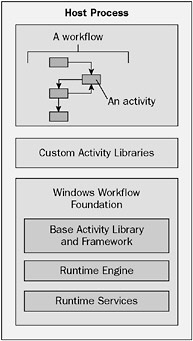Platform Overview
Chapter 1 gives you a high-level view of Windows Workflow Foundation and its architecture. This chapter delves deeper into what you were introduced to earlier. Figure 3-1 shows the workflow stack.

Figure 3-1
It’s a Foundation
One of the most basic things to understand about Windows Workflow Foundation, but initially one of the biggest misconceptions, is that it is a framework for developing workflow-based systems. It is not a server- or client-based product (like Office or SharePoint is a product). Neither is it a language (like C# or VB.NET).
You do not just install, configure, and run Windows Workflow Foundation, and then you have workflow. Just as with Windows Forms and ASP.NET, Windows Workflow Foundation provides a foundation on which to build workflow-based systems. All the pieces required to build workflows and manipulate the workflow infrastructure are provided. The rest is up to you.
Who Is It For?
Although there have been many predictions that software will someday be developed by business users, and certain products do indeed seem to be headed in that direction, Windows Workflow Foundation is still largely a tool for developers - at least during the development cycle. Even though workflows are developed largely with a visual and declarative model, there is still a lot to be done in the background.
Additionally, many of the common tasks performed during a workflow project include the development of .NET code. Obviously, these types of tasks need to be performed by traditional developers. The learning curve related to the tools is simply too high to expect workflows to be developed from scratch by anyone but developers.
EAN: 2147483647
Pages: 118